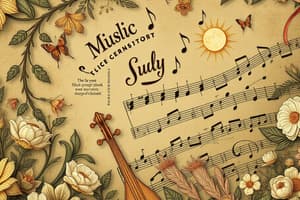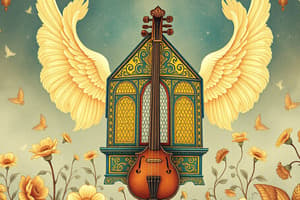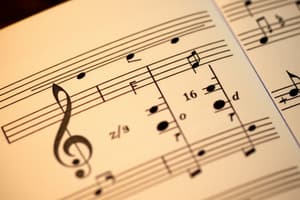Podcast
Questions and Answers
What is rhythm?
What is rhythm?
- The organization of beats into groups
- The surface activity of music based on duration of musical sounds (correct)
- The underlying pulse of music
- The rate of speed of beats
What is beat in music?
What is beat in music?
The underlying pulse of music, equal sounds
Define tempo.
Define tempo.
Rate of speed of beats
What is meter in music?
What is meter in music?
What is duple meter?
What is duple meter?
Define triple meter.
Define triple meter.
What is quadruple meter?
What is quadruple meter?
What is a measure in music?
What is a measure in music?
What are bar lines?
What are bar lines?
What does non-metric music refer to?
What does non-metric music refer to?
Define syncopation in music.
Define syncopation in music.
What is a melody?
What is a melody?
What does interval mean in music?
What does interval mean in music?
Define melodic structure.
Define melodic structure.
What is a phrase in music?
What is a phrase in music?
What is a cadence?
What is a cadence?
What is an incomplete cadence?
What is an incomplete cadence?
What does a complete cadence signify?
What does a complete cadence signify?
Define a musical sentence.
Define a musical sentence.
What is a sequence in music?
What is a sequence in music?
What is harmony?
What is harmony?
Define a chord.
Define a chord.
What is a broken chord?
What is a broken chord?
What does progression mean in music?
What does progression mean in music?
What is a scale?
What is a scale?
Define tonic.
Define tonic.
What is major mode characterized by?
What is major mode characterized by?
Define minor mode.
Define minor mode.
What does modulation refer to in music?
What does modulation refer to in music?
What is consonance?
What is consonance?
Define dissonance.
Define dissonance.
What is musical texture?
What is musical texture?
Define monophonic texture.
Define monophonic texture.
What is polyphonic texture?
What is polyphonic texture?
What does imitation mean in music?
What does imitation mean in music?
What is another word for polyphonic texture?
What is another word for polyphonic texture?
Define homophonic texture.
Define homophonic texture.
What is inversion in music?
What is inversion in music?
Define retrograde.
Define retrograde.
What does augmentation mean?
What does augmentation mean?
Define diminution.
Define diminution.
What is musical form?
What is musical form?
What does repetition mean in music?
What does repetition mean in music?
Define contrast in music.
Define contrast in music.
What does variation mean?
What does variation mean?
What is binary form?
What is binary form?
Define ternary form.
Define ternary form.
What is a theme in music?
What is a theme in music?
What is a motive?
What is a motive?
What does movement refer to in music?
What does movement refer to in music?
What does dynamics refer to?
What does dynamics refer to?
Define pizzicato.
Define pizzicato.
What is a double stop?
What is a double stop?
What does vibrato mean?
What does vibrato mean?
Define tremolo.
Define tremolo.
What are harmonics?
What are harmonics?
What is a mute?
What is a mute?
Define single reed instruments.
Define single reed instruments.
What are double reed instruments?
What are double reed instruments?
What does articulation mean?
What does articulation mean?
What is legato?
What is legato?
Define staccato.
Define staccato.
What does genre mean?
What does genre mean?
What is medium in music?
What is medium in music?
What are the years for the medieval period/middle ages?
What are the years for the medieval period/middle ages?
Define sacred music.
Define sacred music.
What is secular music?
What is secular music?
Define Gregorian chant.
Define Gregorian chant.
What is a syllabic setting in music?
What is a syllabic setting in music?
Define melismatic.
Define melismatic.
What are old church modes?
What are old church modes?
Define organum.
Define organum.
What is the mass?
What is the mass?
Define motet.
Define motet.
What are troubadours/trouveres?
What are troubadours/trouveres?
Define jongleurs.
Define jongleurs.
What is Machaut known for?
What is Machaut known for?
Define chanson.
Define chanson.
What are the years for the Renaissance period?
What are the years for the Renaissance period?
What is a cappella music?
What is a cappella music?
What is word painting in music?
What is word painting in music?
Who is Josquin?
Who is Josquin?
What is the ordinary of the mass?
What is the ordinary of the mass?
What does Kyrie mean?
What does Kyrie mean?
What does Gloria mean?
What does Gloria mean?
What does Credo refer to?
What does Credo refer to?
What does Sanctus mean?
What does Sanctus mean?
What does Agnus Dei mean?
What does Agnus Dei mean?
What is Palestrina known for?
What is Palestrina known for?
What is a madrigal?
What is a madrigal?
Define reformation/counter-reformation.
Define reformation/counter-reformation.
Flashcards are hidden until you start studying
Study Notes
Music Terminology
- Rhythm: Surface activity based on sound duration in music.
- Beat: Underlying pulse of music, characterized by equal sounds.
- Tempo: Speed at which beats occur.
- Meter: Organization of beats into structured groups or patterns.
- Duple Meter: Musical pattern of strong-weak beats (I>uI>uI).
- Triple Meter: Musical pattern of strong-weak-weak beats (I>uuI>uuI).
- Quadruple Meter: Musical pattern with a strong-weak- medium-weak structure (I>u>uI>u>uI).
- Measure: Length of a specific pattern of beats.
- Bar Lines: Vertical lines indicating the start and end of beat patterns.
- Non-Metric: Music lacking a strong sense of beat or meter.
Musical Expression
- Syncopation: Accentuation of beats that are typically unstressed.
- Melody: Sequence of single pitches arranged rhythmically.
- Interval: Distance between two musical pitches.
- Melodic Structure: Melodies reflect linguistic patterns.
- Phrase: Incomplete melodic idea typically concluded by a cadence.
- Cadence: Resting point marking the end of a musical phrase.
- Incomplete Cadence: Suggests continuation after a resting point.
- Complete Cadence: Signifies closure and completion of a piece.
- Musical Sentence: Complete thought in music concluding with a complete cadence.
Harmony and Chords
- Sequence: Repetition of a melodic fragment at varying pitch levels.
- Harmony: The simultaneous sounding of two or more notes.
- Chord: A grouping of three or more notes.
- Broken Chord: Playing the notes of a chord individually.
- Progression: Transition from one chord to another.
- Scale: Ordered series of pitches.
- Tonic: First and most crucial note of a scale, often called the key.
- Major Mode: Typically associated with a happy sound.
- Minor Mode: Often evokes a sad sound.
- Modulation: Shift from one key to another.
Musical Texture
- Consonance: Pleasing combinations of pitches.
- Dissonance: Clashing combinations of pitches.
- Musical Texture: Relationship and layering of musical sounds.
- Monophonic Texture: Single, unaccompanied melodic line.
- Polyphonic Texture: Multiple melodies layered together.
- Imitation: Melodic idea presented and restated in different parts.
- Counterpoint: Alternative reference for polyphonic texture.
- Homophonic Texture: A melody accompanied by chords or harmony.
Melodic Techniques
- Inversion: Melody presented upside down.
- Retrograde: Melody played backwards.
- Augmentation: Lengthening the duration of musical notes.
- Diminution: Shortening the duration of musical notes.
Musical Structure
- Musical Form: Arrangement of musical ideas.
- Repetition: Restatement of a musical idea or section.
- Contrast: Variability in the music.
- Variation: Modified version of previously heard material.
- Binary Form: Structure consisting of two contrasting sections (AB).
- Ternary Form: Form with three sections, typically ABA.
- Theme: Melodic idea serving as a foundational element of a composition.
- Motive: Smallest building block of music.
- Movement: Complete musical unit within a larger work.
Dynamics and Articulation
- Dynamics: Variations in loudness and softness.
- Pizzicato: Technique of plucking strings with fingers.
- Double Stop: Plucking two strings simultaneously.
- Vibrato: Rocking motion of the finger on a string.
- Tremolo: Rapid bowing of a single note.
- Harmonics: High pitches obtained by lightly touching a string.
- Mute: Device used to soften the tone of an instrument.
Instrument Classification
- Single Reed Instruments: Include clarinets and saxophones.
- Double Reed Instruments: Include oboe, English horn, and bassoon.
- Articulation: Manner in which individual notes are played.
- Legato: Smooth and connected notes.
- Staccato: Notes played in a detached manner.
Historical Context
- Genre: Broad categories of musical works.
- Medium: Instruments used to perform music.
- Medieval Period (Middle Ages): 450-1450.
- Sacred Music: Music associated with religious worship.
- Secular Music: Non-religious musical expressions.
Noteworthy Concepts
- Gregorian Chant: Official chant of the Roman Catholic Church.
- Syllabic: Each syllable set to one note.
- Melismatic: Multiple notes for a single syllable.
- Old Church Modes: Scales from medieval and renaissance periods.
- Organum: Early example of polyphonic music from around 1000 AD.
- The Mass: Official liturgical rite of the Roman Catholic Church.
- Motet: Sacred vocal composition in polyphony, typically a cappella.
- Troubadours/Trouveres: Higher-class poet-singer-composers.
- Jongleurs: Lower-class performers with a less reputable status.
- Machaut: Key 14th-century composer, noted for his mass settings.
- Chanson: Songs derived from courtly love poetry.
Renaissance Insights
- Renaissance Period: 1450-1600.
- A Capella: Vocal music without instrumental backing.
- Word Painting: Musical gestures illustrate the meaning of the text.
- Josquin: Significant Renaissance composer around 1500.
- Ordinary of the Mass: Refers to liturgical fixed texts.
- Kyrie: A plea for mercy.
- Gloria: Expression of praise.
- Credo: Declaration of beliefs.
- Sanctus: Expression of praise.
- Agnus Dei: Prayer for mercy.
- Palestrina: Composer known for clear text settings in homophonic texture.
- Madrigal: Secular vocal music derived from motets, often romantic in text.
- Reformation/Counter-Reformation: Movement rejecting Catholic authority.
Studying That Suits You
Use AI to generate personalized quizzes and flashcards to suit your learning preferences.




